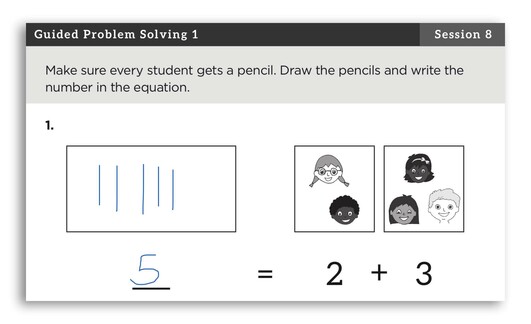Open Resources

The ICUE student workbook is 316 pages. It consists of 32 sessions designed to be administered twice a week for 16 weeks. Each session takes approximately 20 minutes when used in a whole classroom setting, or 15 minutes when used in a 2:1 tutoring session. The CLAD Lab and WestEd are currently working on a project that involves moving the independent problem-solving pages to an electronic format to reduce paper waste and to examine if providing customized feedback on a problem-by-problem basis improves children's learning even more.
The ICUE teacher manual is 139 pages. It presents learning objects, materials, and clarifying questions for each session. Note that is common for teachers, tutors, students, and parents to look at the first several lessons and think the content seems "too easy." However, these early sessions are specifically designed to activate children's informal understanding of equivalence in contexts like sharing and balancing. This allows children's informal understanding to be linked to the abstract mathematical symbols to facilitate comprehension and retention.
ICUE Components Explained
Vary the problem format
One easy way for educators to help promote understanding of mathematical equivalence is to present arithmetic problems in a variety of problem formats, rather than only sticking to the traditional "operations = answer" format.
This simple modification to the structure of arithmetic practice is helpful, but it is not enough on its own to help all children construct a formal understanding of math equivalence. Fortunately, there are three additional activities in ICUE that help children construct understanding of mathematical equivalence. Two experiments have found that the additional components in ICUE improve children's understanding beyond the improvements seen with the non-traditional arithmetic practice alone.
Introduce the equal sign outside of the arithmetic context
Regardless of the problem format, arithmetic problems may activate unhelpful, operational ways of thinking about the equal sign. For this reason, it is helpful to start by teaching the relational meaning of the equal sign outside of an arithmetic context (e.g., 7 = 7) before starting to incorporate it within the context of arithmetic.
Concreteness fading
Children have accurate, informal understandings of equivalence relations in everyday contexts such as sharing stickers or balancing a scale. Educators can ask children to solve problems in these familiar, concrete relational contexts and then link those concrete contexts to the abstract math symbols before slowly fading away the concrete contexts.
Compare and explain
Educators can help children construct deep and robust understanding of mathematical equivalence by asking children to compare and explain different problem formats and different problem-solving strategies. When educators ask children to engage in comparison and explanation, they show them that we value attentive and mindful problem solving.
Materials List
ICUE-specific materials
Balance scale with weights (one for every 3 students)
Packs of large foam stickers (36 stickers per classroom)
Packs of small stickers (one package of tiny dot stickers would be sufficient)
Name badges (3)
Common classroom materials
Stopwatch or minute timer (1)
Colored pencils (3 packs per classroom)
Construction paper (14 sheets per classroom)
Ziploc plastic bags (one package of 40 would be sufficient)
Permanent marker (1)